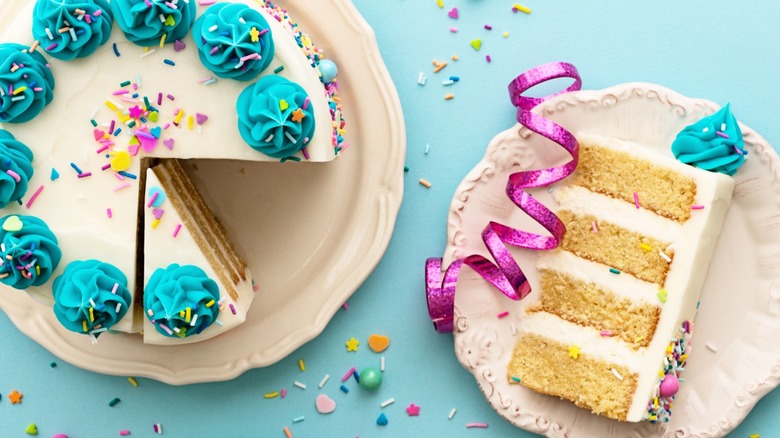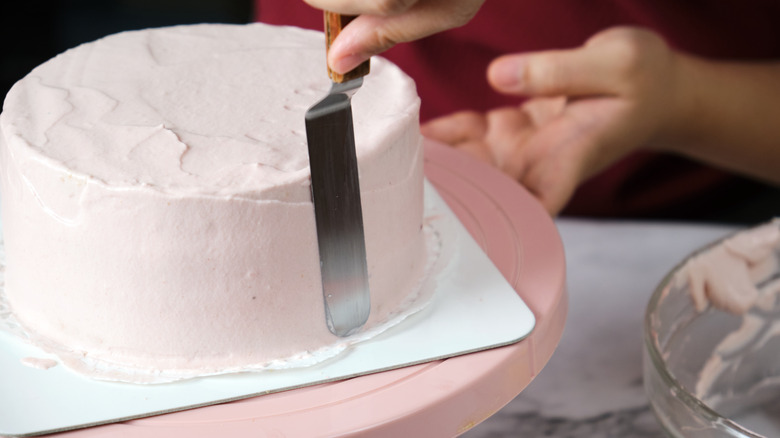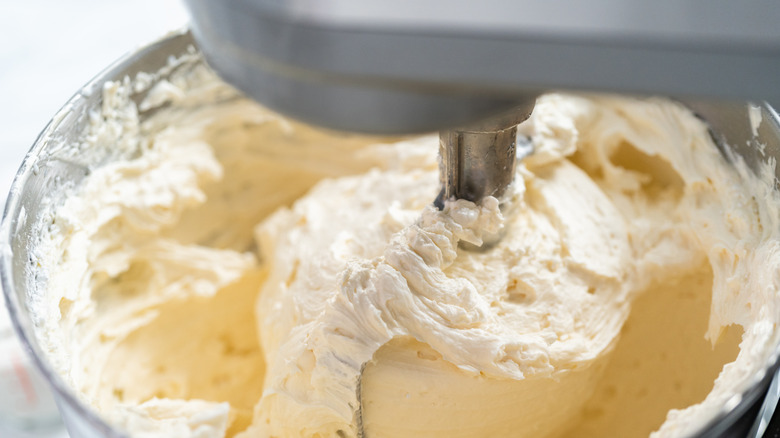The Frosting Mistake That Ruins Make-Ahead Desserts
Dessert is often what dinner guests remember the most and is a prerequisite if throwing a party. Finishing the meal with something sweet, especially a dessert as celebratory as a four-layer cake, makes for a happy ending; however, no one wants to be stuck in the kitchen frosting a cake after dinner.
Cakes can be adorned with various types of frosting, such as ganache, fondant, and ermine, some of which are more complicated to make than others. You may think it's smart to get some of the prep out of the way ahead of your dinner party, but not all frostings hold up when added ahead of time.
Timing is crucial when it comes to whipped cream-based frostings, especially if you're aiming for a flawless dessert. Although it's a lightly sweetened, uncomplicated alternative to dense, overly sweet buttercreams, sweetened whipped cream (or even créme fraîche-based frostings) will not hold up if made in advance. Without a stabilizer, whipped heavy cream flavored with vanilla and confectioners' sugar will weep and deflate, and should be prepared right before your sweet creation graces the table.
How to stabilize whipped cream
If you must have whipped cream, there are several ways to stabilize it. These methods involve additional ingredients and can slightly alter the frosting's flavor and texture. One way is to add more dairy like cream cheese, Italian mascarpone, or crème fraîche. Whisking them with heavy cream and sugar at room temperature will stabilize the frosting for a couple of days in the fridge. Naturally, the added thickness and tang of any of these ingredients will alter the whipped cream's flavor, but that's not necessarily a bad thing.
You can also add a flavorless thickener like cornstarch or King Arthur Baking's ClearJel to stabilize whipped cream frosting. A tablespoon of cornstarch per cup of heavy whipping cream prevents the cream from collapsing and maintains its shape for up to two days. This approach is especially helpful for preparing strawberry shortcakes.
If you don't want to risk it or are planning to pipe decorations like flowers on the cake, stick to meringue-based buttercreams (German, Swiss, French, Italian, and American) that will hold up in the refrigerator.
European buttercreams are a safer option
Italian buttercream is notably stable, making it the best choice when you want to craft your dessert ahead of time. Like other European buttercreams, it starts with a meringue made from egg whites, sugar, and hot sugar syrup, which is then whipped with softened butter. Given its egg white base, Italian buttercream is effortlessly colored with food dye, and its smooth texture makes it a delight to work with.
French buttercream is similar to its Italian counterpart but made with whole eggs or egg yolks, so it's richer (aka more stable) and tinted a golden color. Swiss and German buttercream are other solid make-ahead options, with the latter being easier and closer to American buttercream.
Of all the buttercreams, American buttercream is the easiest to make. While there's some debate over whether it's a true buttercream, it's versatile and a favorite for children's birthday cakes since it's so sweet. Softened butter and confectioners' sugar are beaten until creamy, with a splash of milk added to adjust the consistency. You can add cocoa for chocolate buttercream.
Remember, buttercream tends to harden in the refrigerator. Therefore, it's best to let cakes frosted with buttercream sit out until they reach room temperature before serving them.



